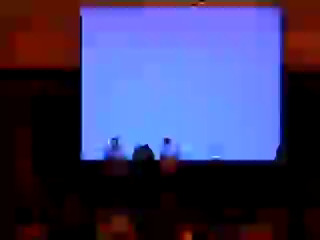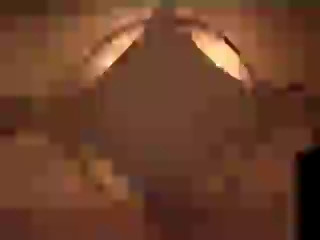20C3 - 20th Chaos Communication Congress - "Not a Number"
Item set
- Title
- 20C3 - 20th Chaos Communication Congress - "Not a Number"
- Veranstaltungsort
- Berlin
- Veranstaltungsdaten
- 27 December 2003
- 28 December 2003
- 29 December 2023
- Administrative Überordnung der Konferenz oder der Veranstaltung
-
 Chaos Computer Club e. V.
Chaos Computer Club e. V.
- Vorherige Konferenz oder Veranstaltung
-
 19C3 - 19th Chaos Communication Congress - "Out of Order"
19C3 - 19th Chaos Communication Congress - "Out of Order"
- Nachfolgende Konferenz oder Veranstaltung
-
 21C3 - 21st Chaos Communication Congress - "The Usual Suspects"
21C3 - 21st Chaos Communication Congress - "The Usual Suspects"
- Tag
- conference
- congress
- congress
- Identifier
- ark:/45490/bQd9vM
Linked resources
| Title | Class |
|---|---|
 21C3 - 21st Chaos Communication Congress - "The Usual Suspects" 21C3 - 21st Chaos Communication Congress - "The Usual Suspects" |
Event |
| Title | Class |
|---|---|
 19C3 - 19th Chaos Communication Congress - "Out of Order" 19C3 - 19th Chaos Communication Congress - "Out of Order" |
Event |
Items
-
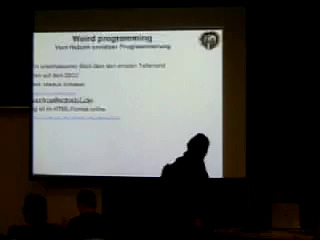 weird programming Inhalt: Eine kurze Rundreise über die Grenzgebiede der Programmierkunst, bei denen der Spass vor dem Nutzen kommt. Beleuchtet wird u. A. Obfuscated Programming, Quines und exotische Programmiersprachen.
weird programming Inhalt: Eine kurze Rundreise über die Grenzgebiede der Programmierkunst, bei denen der Spass vor dem Nutzen kommt. Beleuchtet wird u. A. Obfuscated Programming, Quines und exotische Programmiersprachen. -
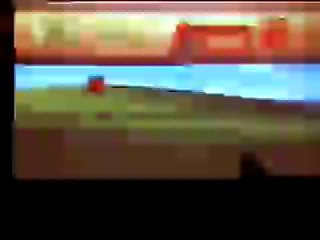 Practical Win32 and UNICODE exploitation The talk could also be called "Lessons learned when the Cisco guys went to Windows land", because there are a number of things quite different in Windows land compared to other environments. One of these things is the frequent use of wide characters and the annoying difficulties that arise from that, including return addresses of 0x00410041. about this event: http://www.ccc.de/congress/2003/fahrplan/event/538.en.html
Practical Win32 and UNICODE exploitation The talk could also be called "Lessons learned when the Cisco guys went to Windows land", because there are a number of things quite different in Windows land compared to other environments. One of these things is the frequent use of wide characters and the annoying difficulties that arise from that, including return addresses of 0x00410041. about this event: http://www.ccc.de/congress/2003/fahrplan/event/538.en.html -
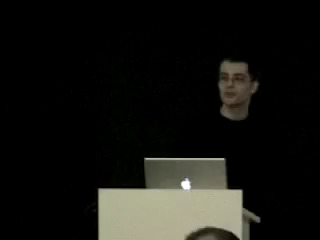 Schummeln in öffentlichen „distributed computing“ Projekten Öffentlich verteilte Berechnungen erfreuen sich im Internet großer Beliebtheit (z.B. SETI@Home, distributed.net, NFSNET, u.v.m.). Mit der wachsenden Beliebtheit dieser Projekte wachsen jedoch auch die Probleme. Ich möchte über SIcherheitsfragen allgemein und das Problem des Schummeln, also das unrechtmäßige Beanspruch von erledigten Arbeitsaufträgen, im Besonderen reden. Es soll (an echten Beispielen) der Schaden durch und mögliche Maßnahmen gegen solchen Missbrauch aufgezeigt werden.
Schummeln in öffentlichen „distributed computing“ Projekten Öffentlich verteilte Berechnungen erfreuen sich im Internet großer Beliebtheit (z.B. SETI@Home, distributed.net, NFSNET, u.v.m.). Mit der wachsenden Beliebtheit dieser Projekte wachsen jedoch auch die Probleme. Ich möchte über SIcherheitsfragen allgemein und das Problem des Schummeln, also das unrechtmäßige Beanspruch von erledigten Arbeitsaufträgen, im Besonderen reden. Es soll (an echten Beispielen) der Schaden durch und mögliche Maßnahmen gegen solchen Missbrauch aufgezeigt werden. -
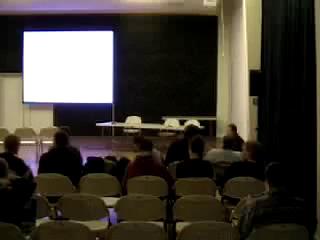 device hacking with jtag TAG is a standardized interface originally defined for testing purposes. It allows controling all external signal pins of a chip using a serial protocol. This allows for board level tests and initial programming of flash ROMs for example. Most complex chips (such as CPUs, FPGAs, CPLDs etc) have this interface. Some CPU manufacturers added hardware assisted debugging support via the JTAG interface. As JTAG is widely used these days, the necessary electrical connections for the JTAG interface are available on most of the currently sold electronic devices. This opens interesting possibilities for hacking these devices. This talk will start with a short introduction on JTAG basics and then proceed on showing how the JTAG interface can be used with some simple hardware and opensource tools to hack existing devices. As an example I will use the work we did on the Dlink DI614+ wireless router. I will end my talk by giving some directions for future development on tools and techniques.
device hacking with jtag TAG is a standardized interface originally defined for testing purposes. It allows controling all external signal pins of a chip using a serial protocol. This allows for board level tests and initial programming of flash ROMs for example. Most complex chips (such as CPUs, FPGAs, CPLDs etc) have this interface. Some CPU manufacturers added hardware assisted debugging support via the JTAG interface. As JTAG is widely used these days, the necessary electrical connections for the JTAG interface are available on most of the currently sold electronic devices. This opens interesting possibilities for hacking these devices. This talk will start with a short introduction on JTAG basics and then proceed on showing how the JTAG interface can be used with some simple hardware and opensource tools to hack existing devices. As an example I will use the work we did on the Dlink DI614+ wireless router. I will end my talk by giving some directions for future development on tools and techniques. -
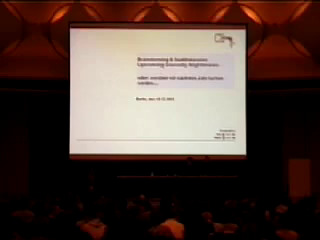 Security Nightmares III Moderated Audience Discussion on "Security Nightmares 2004": which Security-Problems will we stumble upon tomorrow? Which Attack-Methods should we be prepared to defend against? Which major Technology will get hacked next year? We?ll be looking back at last years predictions and then walk upon the thin ice of predicting the future. about this event: http://www.ccc.de/congress/2003/fahrplan/event/609.en.html
Security Nightmares III Moderated Audience Discussion on "Security Nightmares 2004": which Security-Problems will we stumble upon tomorrow? Which Attack-Methods should we be prepared to defend against? Which major Technology will get hacked next year? We?ll be looking back at last years predictions and then walk upon the thin ice of predicting the future. about this event: http://www.ccc.de/congress/2003/fahrplan/event/609.en.html -
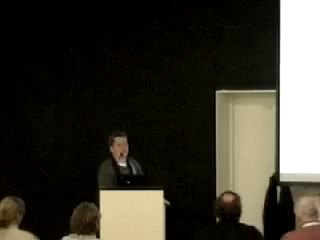 neue notrufnummern fuer die informationsgesellschaft Wir alle besitzen heute immer mehr elektronische Berechtigungen wie ec- und Kreditkarten, Mobiltelefone, sensible Internetanwendungen, elektronische Signaturen. Analog zu den Notrufnummern 110 und 112 der Polizei und Feuerwehr wird die Einführung einer einheitlichen Notrufnummer (z.B. 116) zur Sperrung elektronischer Berechtigungen die Verfahren für den Bürger vereinfachen und im Notfall eine unkomplizierte Hilfestellung zum Sperren leisten können. Vision der neuen Notrufnummer ist die Steigerung des Vertrauens in die Informationsgesellschaft
neue notrufnummern fuer die informationsgesellschaft Wir alle besitzen heute immer mehr elektronische Berechtigungen wie ec- und Kreditkarten, Mobiltelefone, sensible Internetanwendungen, elektronische Signaturen. Analog zu den Notrufnummern 110 und 112 der Polizei und Feuerwehr wird die Einführung einer einheitlichen Notrufnummer (z.B. 116) zur Sperrung elektronischer Berechtigungen die Verfahren für den Bürger vereinfachen und im Notfall eine unkomplizierte Hilfestellung zum Sperren leisten können. Vision der neuen Notrufnummer ist die Steigerung des Vertrauens in die Informationsgesellschaft -
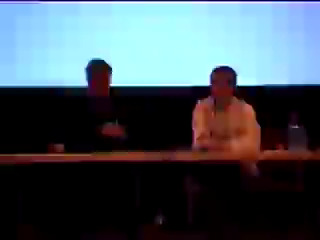 Fragen an eine maschinenlesbare Regierung Der Weltgipfel zur Informationsgesellschaft in Genf zeigte etwa zwei Richtungen von Informationen: Das Wahre und als Chance zur bildungsgestützten Demokratie, Mitsprache "aller". Die Regierungswirklichkeit hinkt dem noch etwas nach, vor allem die deutsche. Sogar die Türkei hat inzwischen ein Informationsfreiheitsgesetz, in Deutschland haben bislang nur einige Bundesländer ein Informationsfreiheitsgesetz. about this event: http://www.ccc.de/congress/2003/fahrplan/event/574.en.html
Fragen an eine maschinenlesbare Regierung Der Weltgipfel zur Informationsgesellschaft in Genf zeigte etwa zwei Richtungen von Informationen: Das Wahre und als Chance zur bildungsgestützten Demokratie, Mitsprache "aller". Die Regierungswirklichkeit hinkt dem noch etwas nach, vor allem die deutsche. Sogar die Türkei hat inzwischen ein Informationsfreiheitsgesetz, in Deutschland haben bislang nur einige Bundesländer ein Informationsfreiheitsgesetz. about this event: http://www.ccc.de/congress/2003/fahrplan/event/574.en.html -
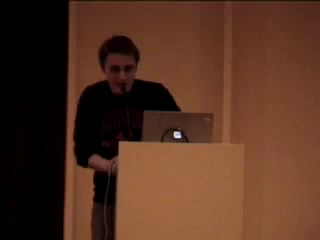 Software-Patente (20c3) EP? Artikel 52 (1973) verbietet Software-Patente. Trotzdem sind seit 1973 ?ber 30.000 Software-Patente erteilt worden. Das Gruselkabinett europ?ischer Software-Patente wurde er?ffnet. Seit eindreiviertel Jahren streiten sich Patent-bef?rworter und Gegner um die letzte EU-Richtlinie mit der die EP? wieder mal umgangen werden konnte. Die Richtlinie soll ge?ndert werden. Vor einem Jahr schon waren die Mitglieder der Essener Linux User Group in Berlin auf dem Chaos Communication Congress um den Bef?rwortern Ihre Meinung zu sagen. Mit einer dreist?ndigen Auff?hrung mit Chor und Klavier, Rap, Kabarett, Werbung, einem Vortrag und dem ersten Patent- verletzungsprogrammierwettbewerb der Geschichte. Dann war der Communication Congress schon wiedervorbei. Die ELUG war noch an weiteren Aktionen beteiligt. * Themenabende * Stand des FFII auf der CeBIT 2003 * Infostand am 20.9.2003 in D?sseldorf * weitere Inzwischen hat sich noch viel mehr bewegt. Einige Beispiele. * 21.1. Europ?ische Kulturkommission stimmt f?r ?nderungen * 15.2. Neue Datenbank und Statistik der EPA Softwarepatente * 28.2. Zeitplan f?r die Diskussion am Europaparlament * 4.4. Petition beim Europaparlament eingereicht * 2.5. Linux Verband LIVE Linux warnt vor der EU-Richtlinie * 7.-8.5. Konferenz in Br?ssel * 10.-13.7. Commedia Triennale und FFII auf dem LinuxTag 2003 * 26.6. Pro-Linux ver?ffentlicht den 23 Seiten Artikel von hjb * 26.8. Attac schreibt einen offenen Brief an das EU-Parlament * 27.8. Demonstration gegen Softwarepatente in Br?ssel Da hilft Es auch nicht weiter den Termin zu verschieben. * 15.9. sterreichische Gr?ne gegen Softwarepatente * 15.9. Offener Brief von 1&1 an die Abgeordneten * 16.9. Zwei Millionen KMU gegen Software-Patente * 18.-23.9. Aktionswoche gegen Software-Patente * 22.9. Websitesperrungen (u.a. auch CCCB e.V.) * 22.9. Eindeutig p?nktlicher Brief von Torvalds und Cox * 23.9. Der F?rderverein f?r Freie Software FFS ver?ffentlicht eine Pressemitteilung und eine Abstimmungsempfehlung * weitere * 23.9. Demonstration in Stra§burg Eine gute Meldung am 24. September 2003: Das europ?ische Parlament hat sich nach heftigen Diskussionen f?r weitgehende ?nderungen an der umstrittenen Richtlinie ?ber die "Patentierbarkeit Computer-implementierter Erfindungen" ausgesprochen. 354 f?r Revisionen in der EU-Richtlinie und 153 dagegen. Doch es ist noch nicht vorbei. Halter von bisher erteilten Patenten sind nat?rlich daran interessiert ihre Patente auch weiter zu behalten. (Die sie aktiv zur Bek?mpfung von Konkurrenz einsetzen.) Eine weitere Meldung am 23. Oktober 2003: Bitkom bezeichnet die Entscheidung des EU-Parlaments als "Irrweg". (Die Toten regen sich noch.) Darum sind wir schon wieder hier um Aufzukl?ren. Software-Patente. Frei nach einem Vortrag von Dr. Peter Gerwinski mit den Originalfolien des ELUG-Themenabends am 20. August 2002 nochmal in meinen eigenen Worten von meinem eigenen Standpunkt aus wiedergegeben.
Software-Patente (20c3) EP? Artikel 52 (1973) verbietet Software-Patente. Trotzdem sind seit 1973 ?ber 30.000 Software-Patente erteilt worden. Das Gruselkabinett europ?ischer Software-Patente wurde er?ffnet. Seit eindreiviertel Jahren streiten sich Patent-bef?rworter und Gegner um die letzte EU-Richtlinie mit der die EP? wieder mal umgangen werden konnte. Die Richtlinie soll ge?ndert werden. Vor einem Jahr schon waren die Mitglieder der Essener Linux User Group in Berlin auf dem Chaos Communication Congress um den Bef?rwortern Ihre Meinung zu sagen. Mit einer dreist?ndigen Auff?hrung mit Chor und Klavier, Rap, Kabarett, Werbung, einem Vortrag und dem ersten Patent- verletzungsprogrammierwettbewerb der Geschichte. Dann war der Communication Congress schon wiedervorbei. Die ELUG war noch an weiteren Aktionen beteiligt. * Themenabende * Stand des FFII auf der CeBIT 2003 * Infostand am 20.9.2003 in D?sseldorf * weitere Inzwischen hat sich noch viel mehr bewegt. Einige Beispiele. * 21.1. Europ?ische Kulturkommission stimmt f?r ?nderungen * 15.2. Neue Datenbank und Statistik der EPA Softwarepatente * 28.2. Zeitplan f?r die Diskussion am Europaparlament * 4.4. Petition beim Europaparlament eingereicht * 2.5. Linux Verband LIVE Linux warnt vor der EU-Richtlinie * 7.-8.5. Konferenz in Br?ssel * 10.-13.7. Commedia Triennale und FFII auf dem LinuxTag 2003 * 26.6. Pro-Linux ver?ffentlicht den 23 Seiten Artikel von hjb * 26.8. Attac schreibt einen offenen Brief an das EU-Parlament * 27.8. Demonstration gegen Softwarepatente in Br?ssel Da hilft Es auch nicht weiter den Termin zu verschieben. * 15.9. sterreichische Gr?ne gegen Softwarepatente * 15.9. Offener Brief von 1&1 an die Abgeordneten * 16.9. Zwei Millionen KMU gegen Software-Patente * 18.-23.9. Aktionswoche gegen Software-Patente * 22.9. Websitesperrungen (u.a. auch CCCB e.V.) * 22.9. Eindeutig p?nktlicher Brief von Torvalds und Cox * 23.9. Der F?rderverein f?r Freie Software FFS ver?ffentlicht eine Pressemitteilung und eine Abstimmungsempfehlung * weitere * 23.9. Demonstration in Stra§burg Eine gute Meldung am 24. September 2003: Das europ?ische Parlament hat sich nach heftigen Diskussionen f?r weitgehende ?nderungen an der umstrittenen Richtlinie ?ber die "Patentierbarkeit Computer-implementierter Erfindungen" ausgesprochen. 354 f?r Revisionen in der EU-Richtlinie und 153 dagegen. Doch es ist noch nicht vorbei. Halter von bisher erteilten Patenten sind nat?rlich daran interessiert ihre Patente auch weiter zu behalten. (Die sie aktiv zur Bek?mpfung von Konkurrenz einsetzen.) Eine weitere Meldung am 23. Oktober 2003: Bitkom bezeichnet die Entscheidung des EU-Parlaments als "Irrweg". (Die Toten regen sich noch.) Darum sind wir schon wieder hier um Aufzukl?ren. Software-Patente. Frei nach einem Vortrag von Dr. Peter Gerwinski mit den Originalfolien des ELUG-Themenabends am 20. August 2002 nochmal in meinen eigenen Worten von meinem eigenen Standpunkt aus wiedergegeben. -
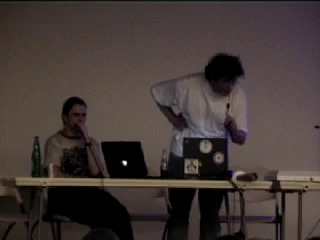 Gute Antennen selber bauen Der Workshop wendet sich an Chaoten, denen die Sende- und Empfangsleistung der eingebauten Antennen nicht genuegt. Speziell werden wir uns mit Anfroderungen an Antennen fuer Wardriver, Richtfunker und fuer MESHs beschaeftigen und auf Moeglichkeiten zum gemeinsamen selberbauen aufzeigen. Thema des Workshops: WLan - Antennenbau Zusammenfassung Grundlagen der 802.11-Familie Grundlagen Funktechnik im GHz-Bereich Antennenformen, insbesondere: * Helix - Richtfunkantennen * Slotted Waveguide - Flaechenantennen * Rundstrahler Moeglichkeiten zum Selberbauen
Gute Antennen selber bauen Der Workshop wendet sich an Chaoten, denen die Sende- und Empfangsleistung der eingebauten Antennen nicht genuegt. Speziell werden wir uns mit Anfroderungen an Antennen fuer Wardriver, Richtfunker und fuer MESHs beschaeftigen und auf Moeglichkeiten zum gemeinsamen selberbauen aufzeigen. Thema des Workshops: WLan - Antennenbau Zusammenfassung Grundlagen der 802.11-Familie Grundlagen Funktechnik im GHz-Bereich Antennenformen, insbesondere: * Helix - Richtfunkantennen * Slotted Waveguide - Flaechenantennen * Rundstrahler Moeglichkeiten zum Selberbauen -
 Chaos Jahresrückblick 2003 about this event: http://www.ccc.de/congress/2003/fahrplan/event/581.en.html
Chaos Jahresrückblick 2003 about this event: http://www.ccc.de/congress/2003/fahrplan/event/581.en.html -
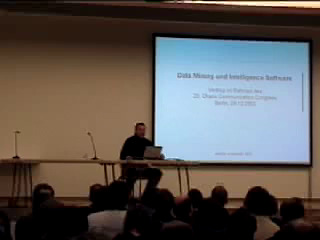 data mining and intelligence software about this event: http://www.ccc.de/congress/2003/fahrplan/event/568.en.html
data mining and intelligence software about this event: http://www.ccc.de/congress/2003/fahrplan/event/568.en.html -
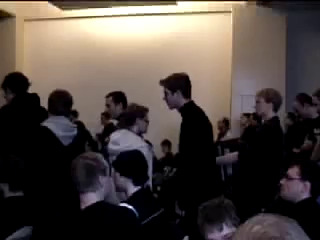 1024 bit rsa ist unsicher Am 23. Januar 2003 veröffentlichten Adi Shamir, einer der Entwickler des RSA Verfahrens zusammmen mit Eran Tromer einen technischen Report über Spezialhardware zur Faktorisierung von grossen Zahlen. Aufhorchen liess insbesondere die Einschätzung, dass mit einem Einsatz von ungefähr 10 Millionen Euro RSA Schlüssel der Länge 1024 bit in unter einem Jahr brechbar sind. In unserem Vortrag geben wir eine (relativ!-) unmathematische Uebersicht ueber den aktuellen Stand der Forschung und diskutieren fuer welche Anwendungen Schluessel eine geringere Schluessellaenge als 2048bit noch aussreicht.
1024 bit rsa ist unsicher Am 23. Januar 2003 veröffentlichten Adi Shamir, einer der Entwickler des RSA Verfahrens zusammmen mit Eran Tromer einen technischen Report über Spezialhardware zur Faktorisierung von grossen Zahlen. Aufhorchen liess insbesondere die Einschätzung, dass mit einem Einsatz von ungefähr 10 Millionen Euro RSA Schlüssel der Länge 1024 bit in unter einem Jahr brechbar sind. In unserem Vortrag geben wir eine (relativ!-) unmathematische Uebersicht ueber den aktuellen Stand der Forschung und diskutieren fuer welche Anwendungen Schluessel eine geringere Schluessellaenge als 2048bit noch aussreicht. -
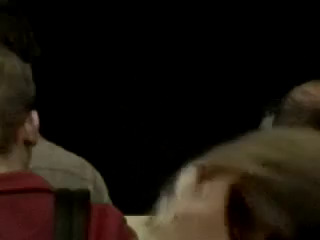 softwarekunstprojekt runme.org So, wie sich runme.org äußerlich nicht an Kunst-Websites, sondern an Freie Software-Plattformen wie Freshmeat.net und sweetcode.org anlehnt und auch zu einem erheblichen Teil Hacker-Code featured (Quines z.B., Programmiersprachen wie Mindfuck, Tempest for Eliza etc.), der nicht aus dem Kunstbetrieb kommt, möchten wir auch keinen Medienkunstdiskurs führen, sondern Brücken schlagen zwischen Software-Hacks und Kunst. Wir hoffen auf ein kritisches Feedback von einem technisch intelligenten Publikum, und natürlich wollen wir auch Sympathiewerbung bei Programmierern machen, die ihre Arbeit als Kunst verstehen und sie in Zukunft auch auf runme.org präsentieren könnten.
softwarekunstprojekt runme.org So, wie sich runme.org äußerlich nicht an Kunst-Websites, sondern an Freie Software-Plattformen wie Freshmeat.net und sweetcode.org anlehnt und auch zu einem erheblichen Teil Hacker-Code featured (Quines z.B., Programmiersprachen wie Mindfuck, Tempest for Eliza etc.), der nicht aus dem Kunstbetrieb kommt, möchten wir auch keinen Medienkunstdiskurs führen, sondern Brücken schlagen zwischen Software-Hacks und Kunst. Wir hoffen auf ein kritisches Feedback von einem technisch intelligenten Publikum, und natürlich wollen wir auch Sympathiewerbung bei Programmierern machen, die ihre Arbeit als Kunst verstehen und sie in Zukunft auch auf runme.org präsentieren könnten. -
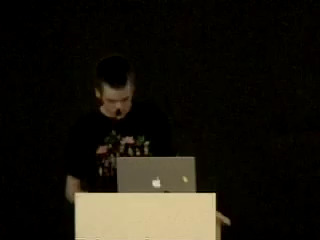 Soziale Software Ein Einblick in die Vielfalt der sozialen Software (Chatsysteme, Forensysteme, Publishingsysteme), und kritische Auseinandersetzung mit derselben. Erreicht man mit sozialer Software ueberhaupt relevante Ziele? Kann man Redefreiheit und sinnvolle Kommunikation vereinen, und wenn ja, wie? Weiterhin Vorstellung von (neuen?) Ideen zu sozialer Software, und was sie bringen koennten. Technik hat immer soziale Auswirkungen, und zu sagen, dass man soziale Probleme nicht durch Technik loesen kann, verschleiert nur die Tatsache, dass man durch Technik sehr wohl soziale Probleme herstellen kann.
Soziale Software Ein Einblick in die Vielfalt der sozialen Software (Chatsysteme, Forensysteme, Publishingsysteme), und kritische Auseinandersetzung mit derselben. Erreicht man mit sozialer Software ueberhaupt relevante Ziele? Kann man Redefreiheit und sinnvolle Kommunikation vereinen, und wenn ja, wie? Weiterhin Vorstellung von (neuen?) Ideen zu sozialer Software, und was sie bringen koennten. Technik hat immer soziale Auswirkungen, und zu sagen, dass man soziale Probleme nicht durch Technik loesen kann, verschleiert nur die Tatsache, dass man durch Technik sehr wohl soziale Probleme herstellen kann. -
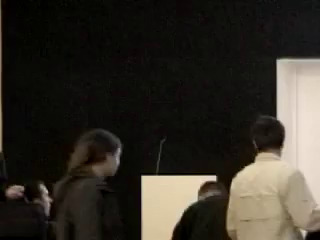 der Zettel am Bildschirm Der Zettel am Bildschirm: Psychologische Aspekte von Computersicherheit in Organisationen Die vorliegende Untersuchung befasst sich mit der Frage nach dem IT-Sicherheitsbewusstsein in Organisationen aus der Sicht von Anwendern und Administratoren. Mit Hilfe eines selbst erstellten Fragebogens soll untersucht werden, wie stark das IT-Sicherheitsbewusstsein unter Anwendern und Administratoren ausgeprägt ist und welche Probleme sich diesbezüglich ergeben. Ausgehend von Alltagsbeobachtungen kann man auf der Seite der User in Organisationen folgende Annahmen über Probleme der IT-Sicherheit in Organisationen aufstellen: Der durchschnittliche Computer-User in Organisationen fühlt sich bezüglich der IT-Sicherheit nicht richtig geschult und über existierende Policies zur IT-Sicherheit nicht richtig informiert. Andererseits scheint bei Usern in Organisationen kein großes Interesse an Kenntnissen zur IT-Sicherheit vorhanden zu sein. Die User sind nicht bereit, sich mit Computerproblemen, die über ihr Arbeitsgebiet hinausgehen, auseinanderzusetzen. Es wird zudem angenommen, dass sie sich durch Anweisungen von Admins zur IT-Sicherheit in Ihrer Arbeit eingeschränkt fühlen. Auf der Seite der Administratoren wird vermutet, dass Verantwortliche in Organisationen Maßnahmen zur IT-Sicherheit nicht gern wahrnehmen, weil sie einen hohen Kostenfaktor darstellen und die Einsparungen, die sie mit sich bringen, nicht direkt wahrnehmbar sind. Dies führt dazu, dass Schulungen zur IT-Sicherheit in Unternehmen in der Regel nur einmalig oder gar nicht stattfinden. Aus den Ergebnissen sollen Schlussfolgerungen für die Verbesserung des IT-Sicherheitsbewusstseins in Organisationen auf Seiten der User und auf Seiten der Administratoren und Verantwortlichen gezogen werden.
der Zettel am Bildschirm Der Zettel am Bildschirm: Psychologische Aspekte von Computersicherheit in Organisationen Die vorliegende Untersuchung befasst sich mit der Frage nach dem IT-Sicherheitsbewusstsein in Organisationen aus der Sicht von Anwendern und Administratoren. Mit Hilfe eines selbst erstellten Fragebogens soll untersucht werden, wie stark das IT-Sicherheitsbewusstsein unter Anwendern und Administratoren ausgeprägt ist und welche Probleme sich diesbezüglich ergeben. Ausgehend von Alltagsbeobachtungen kann man auf der Seite der User in Organisationen folgende Annahmen über Probleme der IT-Sicherheit in Organisationen aufstellen: Der durchschnittliche Computer-User in Organisationen fühlt sich bezüglich der IT-Sicherheit nicht richtig geschult und über existierende Policies zur IT-Sicherheit nicht richtig informiert. Andererseits scheint bei Usern in Organisationen kein großes Interesse an Kenntnissen zur IT-Sicherheit vorhanden zu sein. Die User sind nicht bereit, sich mit Computerproblemen, die über ihr Arbeitsgebiet hinausgehen, auseinanderzusetzen. Es wird zudem angenommen, dass sie sich durch Anweisungen von Admins zur IT-Sicherheit in Ihrer Arbeit eingeschränkt fühlen. Auf der Seite der Administratoren wird vermutet, dass Verantwortliche in Organisationen Maßnahmen zur IT-Sicherheit nicht gern wahrnehmen, weil sie einen hohen Kostenfaktor darstellen und die Einsparungen, die sie mit sich bringen, nicht direkt wahrnehmbar sind. Dies führt dazu, dass Schulungen zur IT-Sicherheit in Unternehmen in der Regel nur einmalig oder gar nicht stattfinden. Aus den Ergebnissen sollen Schlussfolgerungen für die Verbesserung des IT-Sicherheitsbewusstseins in Organisationen auf Seiten der User und auf Seiten der Administratoren und Verantwortlichen gezogen werden. -
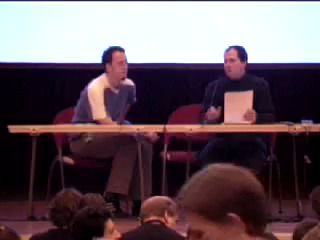 Abschlussveranstaltung about this event: http://www.ccc.de/congress/2003/fahrplan/event/610.en.html
Abschlussveranstaltung about this event: http://www.ccc.de/congress/2003/fahrplan/event/610.en.html -
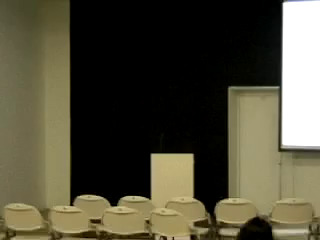 Secure Internet Live Conferencing with SILC The SILC Project develops the Secure Internet Live Conferencing protocol (SILC), which is designed to provide most rich featured conferencing services and high security. In short, it's irc done right. To kick off the presentation we walk quickly through the features of SILC demonstrating the silc-Irssi. Afterwards we are going to look at the silc network and the silc protocols.
Secure Internet Live Conferencing with SILC The SILC Project develops the Secure Internet Live Conferencing protocol (SILC), which is designed to provide most rich featured conferencing services and high security. In short, it's irc done right. To kick off the presentation we walk quickly through the features of SILC demonstrating the silc-Irssi. Afterwards we are going to look at the silc network and the silc protocols. -
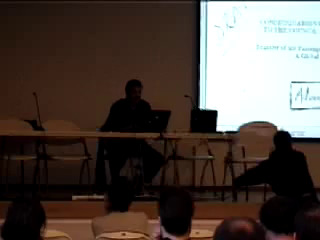 The quintessenz biometrics doq/ubase The biometrics doq/ubase is a fast growing collection of biometrics related documents focusing on the current processes of worldwide biometrics standardization implementation thereof in machine readable travel documents e.g. European passports. Most of the documents originate from international bodies like ISO or ICAO, from political institutions [US, EU], biometrics related companies, various industry lobby groups and government agencies like the NSA. There are more ways to do profiling and mining like the DNA-profiling cops do. In the same way human beings leave biological marks at scenes of crime standardisation workgroups and government buraeucrats leave documents on scenes of discussions and decisions howe to index the civil community. Like DNA-profiling we examine their documents by text mining and find out who was involved and who gave the orders. Timelines, catchphrases and real names will be used to display the intermingled network of organisations, companies, police and other government agencies .
The quintessenz biometrics doq/ubase The biometrics doq/ubase is a fast growing collection of biometrics related documents focusing on the current processes of worldwide biometrics standardization implementation thereof in machine readable travel documents e.g. European passports. Most of the documents originate from international bodies like ISO or ICAO, from political institutions [US, EU], biometrics related companies, various industry lobby groups and government agencies like the NSA. There are more ways to do profiling and mining like the DNA-profiling cops do. In the same way human beings leave biological marks at scenes of crime standardisation workgroups and government buraeucrats leave documents on scenes of discussions and decisions howe to index the civil community. Like DNA-profiling we examine their documents by text mining and find out who was involved and who gave the orders. Timelines, catchphrases and real names will be used to display the intermingled network of organisations, companies, police and other government agencies . -
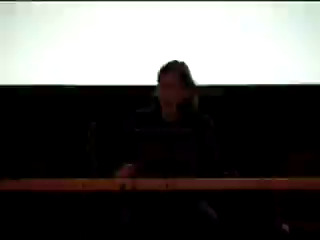 AN.ON and the future of anonymziers in Germany Der Vortrag befasst sich in erster Linie mit der rechtlichen Situation des AN.ON-Projektes und gibt einen Überblick über Gesetze, die das Projekt in Zukunft behindern oder aber auch stärken können. Weiterhin werden die Geschehnisse während des Rechtsstreits mit dem BKA beleuchtet. Dabei wird die Technik hinter JAP beleuchtet und mögliche Alternativen (z.B. p2p in den JAP-Kaskaden) diskutiert.
AN.ON and the future of anonymziers in Germany Der Vortrag befasst sich in erster Linie mit der rechtlichen Situation des AN.ON-Projektes und gibt einen Überblick über Gesetze, die das Projekt in Zukunft behindern oder aber auch stärken können. Weiterhin werden die Geschehnisse während des Rechtsstreits mit dem BKA beleuchtet. Dabei wird die Technik hinter JAP beleuchtet und mögliche Alternativen (z.B. p2p in den JAP-Kaskaden) diskutiert. -
 RFID - Chips mit Antenne für eindeutige Nummern RFIDs (Radio Frequency IDentification) sind Chips mit Antenne, die ihre Kennung auf kurze Entfernungen mittels Transpondern aussenden können. Viele Anwendungen sind gemacht und gedacht: Zugangssysteme, funkende Seriennummern auf Geldscheinen und Waren im Supermarkt. Tracking von Collies in der Logistikkette, Personenidentifikation (nicht nur zur Zugangskontrolle, RFID auf dem Ausweis kommt bestimmt, und eine Gefahr wird's, wenn es gelingt, aus biometrischen Messmengen IDs zu rechnen), Lagerorganisation, Tracken von Material im Produktionslager, ... Wir spielen ein bißchen mit einem Lese/Schreibegerät und gucken uns um, was da auf uns zukommt und überlegen, wie versteckt angebrachte Transponder (mittels eines zu entwickelnden "DataPrivatizers") gefunden werden können. Auch ein paar Mythen werden geradegerückt. Wir beleuchten, wo RFIDs segensreich sein könenn und wo sie uns die Hölle auf Erden bereiten können. Der Workshop ist für interessierte EinsteigerInnen und auch angehende Fachleute geeignet. Und: Wir freuen uns auf die Fachleute im Publikum, die sicherlich auch das eine oder andere beitragen können. Doku zur Testhardware und Folien stellen wir bereit. Wir arbeiten mit dem Development Kit mit 13,56 MHz ISO-Reader für ISO-Transponder nach ISO/IEC 15693
RFID - Chips mit Antenne für eindeutige Nummern RFIDs (Radio Frequency IDentification) sind Chips mit Antenne, die ihre Kennung auf kurze Entfernungen mittels Transpondern aussenden können. Viele Anwendungen sind gemacht und gedacht: Zugangssysteme, funkende Seriennummern auf Geldscheinen und Waren im Supermarkt. Tracking von Collies in der Logistikkette, Personenidentifikation (nicht nur zur Zugangskontrolle, RFID auf dem Ausweis kommt bestimmt, und eine Gefahr wird's, wenn es gelingt, aus biometrischen Messmengen IDs zu rechnen), Lagerorganisation, Tracken von Material im Produktionslager, ... Wir spielen ein bißchen mit einem Lese/Schreibegerät und gucken uns um, was da auf uns zukommt und überlegen, wie versteckt angebrachte Transponder (mittels eines zu entwickelnden "DataPrivatizers") gefunden werden können. Auch ein paar Mythen werden geradegerückt. Wir beleuchten, wo RFIDs segensreich sein könenn und wo sie uns die Hölle auf Erden bereiten können. Der Workshop ist für interessierte EinsteigerInnen und auch angehende Fachleute geeignet. Und: Wir freuen uns auf die Fachleute im Publikum, die sicherlich auch das eine oder andere beitragen können. Doku zur Testhardware und Folien stellen wir bereit. Wir arbeiten mit dem Development Kit mit 13,56 MHz ISO-Reader für ISO-Transponder nach ISO/IEC 15693 -
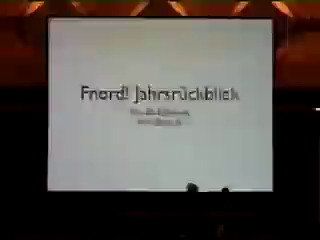 Fnord-Jahresrückschau Was wäre die Zeit vor Sylvester ohne einen Jahresrückblick? Dieser Jahresrückblick wird chronologisch einige Meldungen aus teilweise eher obskuren und alternativen Quellen aufgreifen, um so für den sich nur über Heise und Tagesschau informierenden Geek mal live zu zeigen, was er so an Tagesgeschehen verpaßt hat. Die Veranstaltung ist nicht bloß als Vorlesung oder Alternativ-Tagesschau gedacht, sondern soll durchaus auch in eine Diskussion münden, wie man sich am besten von den gleichgeschalteten Medien emanzipieren kann. about this event: http://www.ccc.de/congress/2003/fahrplan/event/633.en.html
Fnord-Jahresrückschau Was wäre die Zeit vor Sylvester ohne einen Jahresrückblick? Dieser Jahresrückblick wird chronologisch einige Meldungen aus teilweise eher obskuren und alternativen Quellen aufgreifen, um so für den sich nur über Heise und Tagesschau informierenden Geek mal live zu zeigen, was er so an Tagesgeschehen verpaßt hat. Die Veranstaltung ist nicht bloß als Vorlesung oder Alternativ-Tagesschau gedacht, sondern soll durchaus auch in eine Diskussion münden, wie man sich am besten von den gleichgeschalteten Medien emanzipieren kann. about this event: http://www.ccc.de/congress/2003/fahrplan/event/633.en.html -
 WSIS - An Overview The World Summit on the Information Society Lessons learned and steps ahead for activists, lobbyists and protesters The World Summit on the Information Society (WSIS) is the latest in a long series of world summits organized by the United Nations that deal with central questions of humanity like the environment, women's rights, development, climate change, etc. At the WSIS, information and communication are on the agenda for the first time. The summit is organized in two phases. The first part just took place in Geneva in early December, the second summit gathering will be in Tunisia in 2005. During the preparations and the summit itself, civil society groups from a diverse spectrum - including hackers, human rights activists, community media journalists, Free Software advocates, or people working on development and global justice - have played an active role inside and outside the official process. They have achieved a lot. They have built new global, regional and national networks, have held important debates and have built links between diverse groups and themes, and last not least have gained considerable influence on the official process - both in terms of content and process. But these small successes still are far from enough. In this panel we want to present the work done so far and discuss the lessons learned. What was and is going on globally and which positions do the different players have? What were the campains and activities of the global civil society? How do we continue or change our work in the second phase? How can you get involved? The panel will start with an illustrated presentation of "the good, the bad, and the ugly of the summit".
WSIS - An Overview The World Summit on the Information Society Lessons learned and steps ahead for activists, lobbyists and protesters The World Summit on the Information Society (WSIS) is the latest in a long series of world summits organized by the United Nations that deal with central questions of humanity like the environment, women's rights, development, climate change, etc. At the WSIS, information and communication are on the agenda for the first time. The summit is organized in two phases. The first part just took place in Geneva in early December, the second summit gathering will be in Tunisia in 2005. During the preparations and the summit itself, civil society groups from a diverse spectrum - including hackers, human rights activists, community media journalists, Free Software advocates, or people working on development and global justice - have played an active role inside and outside the official process. They have achieved a lot. They have built new global, regional and national networks, have held important debates and have built links between diverse groups and themes, and last not least have gained considerable influence on the official process - both in terms of content and process. But these small successes still are far from enough. In this panel we want to present the work done so far and discuss the lessons learned. What was and is going on globally and which positions do the different players have? What were the campains and activities of the global civil society? How do we continue or change our work in the second phase? How can you get involved? The panel will start with an illustrated presentation of "the good, the bad, and the ugly of the summit". -
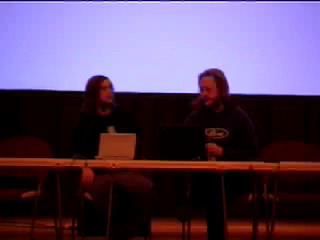 NOC Preview An introduction to the features and capabilities of the computer network at 20C3. We explain how to use IPsec, IPv6 and 802.11a and 802.11b wireless networks. about this event: http://www.ccc.de/congress/2003/fahrplan/event/531.en.html
NOC Preview An introduction to the features and capabilities of the computer network at 20C3. We explain how to use IPsec, IPv6 and 802.11a and 802.11b wireless networks. about this event: http://www.ccc.de/congress/2003/fahrplan/event/531.en.html -
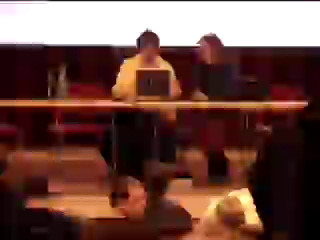 Trusted or Treacherous? Mit der im November 2003 in Amsterdam veröffentlichten TCG 1.2 Spezifikation hat die Trusted Comupting Group erste Schritte in Richtung der Nutzerinteressen gemacht. Eine erste Analyse zeigte jedoch, dass für "Normal-Anwender" zentrale Probleme bestehen bleiben. about this event: http://www.ccc.de/congress/2003/fahrplan/event/542.en.html
Trusted or Treacherous? Mit der im November 2003 in Amsterdam veröffentlichten TCG 1.2 Spezifikation hat die Trusted Comupting Group erste Schritte in Richtung der Nutzerinteressen gemacht. Eine erste Analyse zeigte jedoch, dass für "Normal-Anwender" zentrale Probleme bestehen bleiben. about this event: http://www.ccc.de/congress/2003/fahrplan/event/542.en.html -
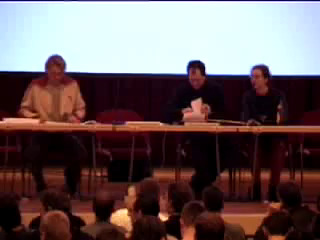 Eröffnung Eröffnung des 20. Chaos Communication Congress und organisatorische Hinweise von Nerd zu Nerd. Im Anschluß: erste öffentliche Präsentation des Dokumentationsvideos des Chaos Communication Camps. about this event: http://www.ccc.de/congress/2003/fahrplan/event/555.en.html
Eröffnung Eröffnung des 20. Chaos Communication Congress und organisatorische Hinweise von Nerd zu Nerd. Im Anschluß: erste öffentliche Präsentation des Dokumentationsvideos des Chaos Communication Camps. about this event: http://www.ccc.de/congress/2003/fahrplan/event/555.en.html -
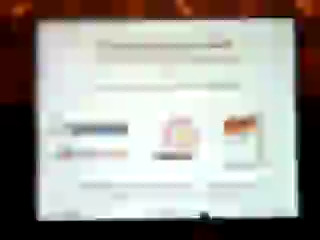 Free WLANs for the masses The presentation "Free WLAN for the Masses" talks about the vision of creating an open network of WiFi hotspots that provide alternative mobile Internet access. about this event: http://www.ccc.de/congress/2003/fahrplan/event/576.en.html
Free WLANs for the masses The presentation "Free WLAN for the Masses" talks about the vision of creating an open network of WiFi hotspots that provide alternative mobile Internet access. about this event: http://www.ccc.de/congress/2003/fahrplan/event/576.en.html -
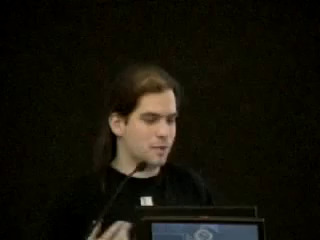 ROCK Linux - Das tool zum erstellen von (Linux) Distributionen Anlaesslich des releases 2.0 wird schoen langsam ein vortrag faellig, nachdem ROCK Linux in den letzten jahren neben OpenBSD sicherlich das groesste projekt im hackcenter war. ROCK Linux ist ein tool um Linux Distributionen zu entwickeln. Roadmap des Vortrages: - Warum braucht die Welt ROCK Linux - Wie kann man mit ROCK Linux distributionen bauen - Wie kann man ROCK Linux erweitern - Beispiel: Wie ist das modul zum builden von dietlibc basierenden distributionen implementiert - Beispiel: Wie ist das modul fuer die PowerPC architektur implementiert - Geplante integration von HURD und OpenBSD kernels - Andere geplante features fuer ROCK Linux 2.1
ROCK Linux - Das tool zum erstellen von (Linux) Distributionen Anlaesslich des releases 2.0 wird schoen langsam ein vortrag faellig, nachdem ROCK Linux in den letzten jahren neben OpenBSD sicherlich das groesste projekt im hackcenter war. ROCK Linux ist ein tool um Linux Distributionen zu entwickeln. Roadmap des Vortrages: - Warum braucht die Welt ROCK Linux - Wie kann man mit ROCK Linux distributionen bauen - Wie kann man ROCK Linux erweitern - Beispiel: Wie ist das modul zum builden von dietlibc basierenden distributionen implementiert - Beispiel: Wie ist das modul fuer die PowerPC architektur implementiert - Geplante integration von HURD und OpenBSD kernels - Andere geplante features fuer ROCK Linux 2.1 -
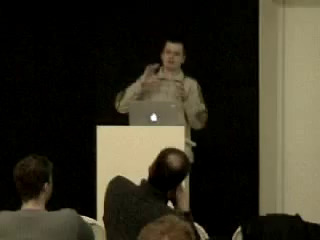 Distributed Computing Dieser Vortrag beschäftigt sich mit dem Einsatz von "distributed computing" Projekten in den Bereichen Bildung, Forschung und Wissenschaft. Nach einer kurzen Übersicht zum allgemeinen Funktionsprinzip von "distributed computing" werden einige ausgewählte Projekte aus den Bereichen Astronomie, Proteinchemie, Molekularbiologie, Arzneimitteldesign, Meteorologie, Evolutionsforschung und Biodiversivität kurz skizziert. Als konkrete Besipiele dienen hier im einzelnen SETI@home, Folding@home/Genome@home, Distributed Folding, CommunityTSC/Find-a-Drug, Climate Prediction, Evolution@home und Lifemapper. Anschließend wird ein kurzer Überblick zu den erforderlichen Hard- und Softwarevoraussetzungen gegeben und schließlich Ziele und aktuelle Projekte der größten deutschen "distributed computing" Gemeinschaft - Rechenkraft.net - kurz vorgestellt. Ziel dieses Vortrags ist es, auf unterhaltsame Art und Weise generell ein etwas breiteres Interesse für "distributed computing" zu wecken und mehr Leute von der Nützlichkeit des "distributed computing" Prinzips zu überzeugen.
Distributed Computing Dieser Vortrag beschäftigt sich mit dem Einsatz von "distributed computing" Projekten in den Bereichen Bildung, Forschung und Wissenschaft. Nach einer kurzen Übersicht zum allgemeinen Funktionsprinzip von "distributed computing" werden einige ausgewählte Projekte aus den Bereichen Astronomie, Proteinchemie, Molekularbiologie, Arzneimitteldesign, Meteorologie, Evolutionsforschung und Biodiversivität kurz skizziert. Als konkrete Besipiele dienen hier im einzelnen SETI@home, Folding@home/Genome@home, Distributed Folding, CommunityTSC/Find-a-Drug, Climate Prediction, Evolution@home und Lifemapper. Anschließend wird ein kurzer Überblick zu den erforderlichen Hard- und Softwarevoraussetzungen gegeben und schließlich Ziele und aktuelle Projekte der größten deutschen "distributed computing" Gemeinschaft - Rechenkraft.net - kurz vorgestellt. Ziel dieses Vortrags ist es, auf unterhaltsame Art und Weise generell ein etwas breiteres Interesse für "distributed computing" zu wecken und mehr Leute von der Nützlichkeit des "distributed computing" Prinzips zu überzeugen.
